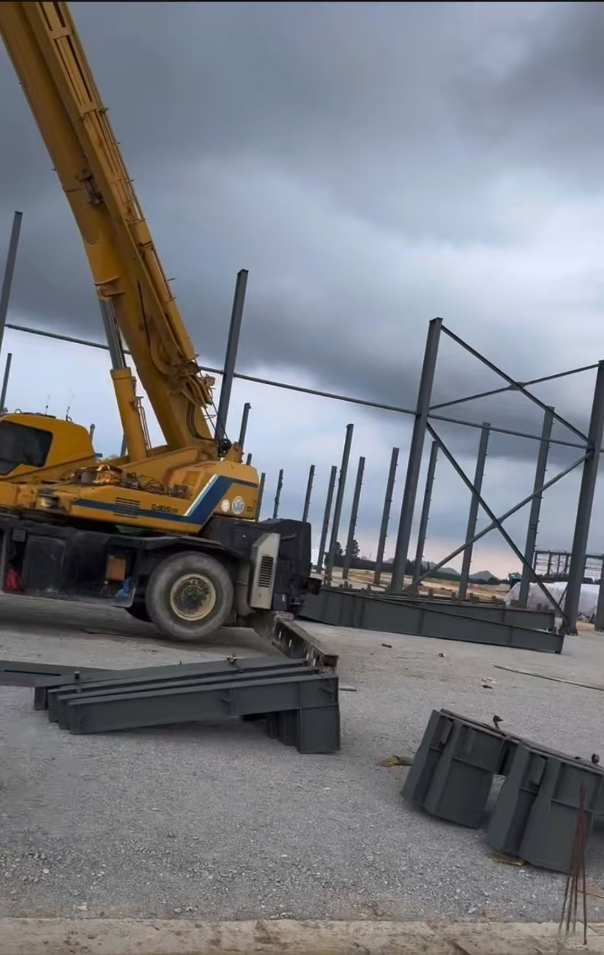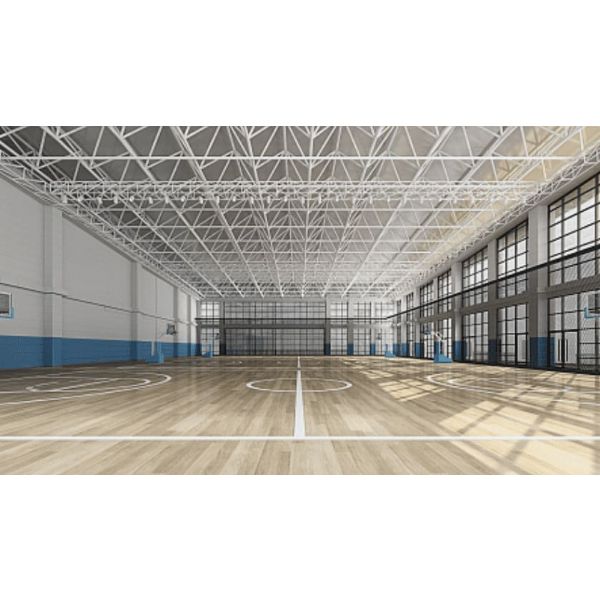Steel Structure Factory Thailand Factory Project Details
The Steel Structure Factory in Thailand is a modern industrial facility delivered with efficiency, safety, and scalability in mind. Completed in April 2021 with a total steel usage of 860 tons, the project demonstrates how a well-engineered steel-framed solution can accelerate time to production while meeting stringent operational requirements. This page provides a comprehensive description of the project scope, engineering concepts, construction methodology, quality assurance, and lifecycle performance—useful for owners and developers considering a similar Steel Structure Factory in Southeast Asia.
Project Snapshot
- Location: Thailand
- Steel Usage: 860 tons
- Completion Time: April 2021
- Facility Type: Integrated production workshop with storage and auxiliary spaces
- Delivery Model: Design–fabrication–erection with coordinated MEP interface
Why Choose a Steel Structure Factory in Thailand?
Thailand offers strategic advantages for export-driven manufacturing—robust logistics corridors, access to ports, and a mature subcontracting ecosystem. A Steel Structure Factory leverages these advantages by enabling faster construction, longer clear spans for process flexibility, and a building shell that adapts to new equipment or layout changes. Compared with traditional concrete-only solutions, steel frames reduce on-site wet works, shorten build times, and simplify future expansion.
Design Intent and Functional Planning
The core design intent was to deliver a durable and easy-to-maintain industrial shell that integrates smoothly with process equipment. The plan aligns structural bays with production lines and material flow, minimizing internal obstructions and accommodating overhead handling equipment where required. Circulation for forklifts and service vehicles is separated from pedestrian routes; docking and dispatch areas are positioned to shorten turnaround time for inbound materials and outbound goods.
Key Functional Zones
- Production Hall: Large-span bays for continuous equipment lines, with provisions for cranes or monorails as needed.
- Storage & Logistics: Racking-compatible floor layouts with loading docks and sheltered canopies for all-weather operations.
- Utilities & MEP: Dedicated spaces for compressors, electrical rooms, and process utilities, isolated for safety and noise control.
- Support Areas: Offices, QC labs, maintenance workshops, and staff amenities positioned for quick access to the shop floor.
Structural Concept and System Selection
To achieve speed and flexibility, the building utilizes a steel portal/frame system with bracing for lateral stability. Primary rigid frames carry gravity and environmental loads, while secondary members support the roof and wall envelope. The configuration provides long, column-free spans for machinery layouts and easy routing of utilities.
Primary Framing
- Main Frames: Welded built-up sections or rolled sections selected to balance weight and stiffness across typical bay spacings.
- Moment Connections: Used at rigid frame haunches to increase rotational capacity and control deflection.
- Lateral System: Portal action supplemented by roof and wall bracing to resist wind and seismic forces per local requirements.
Secondary Members
- Purlins & Girts: Cold-formed members that support roofing and wall cladding; optimized spacing reduces total tonnage.
- Tie Beams & Struts: Control out-of-plane buckling and stabilize the overall system during erection and service.
Foundations and Floor System
Foundations are designed to local geotechnical conditions. The slab is specified for forklift traffic and point loads from racking or equipment skids. Joint layout and hardener options are selected to minimize maintenance in heavy-use aisles.
Envelope and Building Physics
The envelope balances thermal comfort, durability, and energy performance. Roof and wall systems may use insulated sandwich panels (e.g., PU/PIR) or single-skin cladding with internal insulation blankets, depending on process needs and fire-rating requirements. Clerestories or skylights can be added to reduce daytime lighting loads, while ridge ventilators and wall louvers support natural exhaust where appropriate.
Weatherproofing and Durability
- Roofing: High-rib metal roof panels with anti-capillary side laps, compatible with gutters and downpipes sized for local rainfall intensity.
- Wall Cladding: Corrugated or insulated panels with concealed fasteners for improved aesthetics and corrosion resistance.
- Openings: Industrial doors, dock shelters, and canopies designed to control wind-driven rain ingress.
Materials, Corrosion Protection, and Standards
Structural steel selection prioritizes reliable supply and code compliance. Members are fabricated from widely used grades (e.g., materials comparable to S355-class) to ensure predictable performance and weldability. Corrosion protection is provided by factory-applied coatings or hot-dip galvanizing for high-exposure elements. Fasteners, anchor bolts, and accessories are specified to compatible standards to maintain a robust protection system.
Indicative Breakdown of the 860 Tons
Actual distributions vary, but for a project of this scale, a typical allocation is:
- Main Frames & Columns: ~55–65%
- Purlins, Girts, and Secondary Steel: ~10–15%
- Bracing & Tie Systems: ~5–10%
- Miscellaneous (platforms, stairs, crane runways, ancillaries): ~10–20%
Note: Percentages are indicative; the final split depends on span, bay count, crane loads, and envelope choices.
Quality Control and Fabrication Workflow
Fabrication adheres to strict QA/QC procedures from raw material receipt to final coating. Mill certificates verify grade compliance. Dimensional checks ensure beam camber, squareness, and hole tolerances meet drawing requirements. Welds are inspected visually and, where specified, with NDT methods. Shop trials of complex assemblies reduce risk before site delivery.
Logistics, Erection, and Site Management
A sequenced erection plan minimized on-site disruption and supported parallel MEP works. Primary frames were stood and temporarily braced, followed by installation of purlins/girts and roof bracing. Cladding advanced in lockstep with structural progress to achieve a quick dry-in, protecting interior works from weather. Rigging plans, lifting studies, and exclusion zones maintained a high safety standard during hoisting operations.
Construction Timeline Highlights
- Pre-Construction: Shop drawings, procurement, and mock-ups.
- Steel Erection: Frame standing and stabilization, then secondary steel and bracing.
- Envelope & Finishes: Roof/wall systems, doors, canopies, and internal partitions if required.
- MEP & Commissioning: Power, compressed air, lighting, extraction, and final testing.
- Handover: Achieved on schedule in April 2021.
Safety by Design and During Construction
Safety measures are integrated from design through handover. Elevated work platforms, perimeter lines, and railing systems protect workers during erection. Connection details are designed for erector-friendly assembly, reducing time at height. Fire safety is addressed via compliant egress routes, compartmentation where needed, and envelope measures that support the required fire performance.
MEP and Process Integration
The structural grid anticipates cable trays, compressed air mains, and HVAC duct runs. Roof truss/portal spacing allows penetrations for vents without compromising strength. Suspended utility supports prevent floor clutter and keep production lanes clear. Lighting layouts optimize lux levels and glare control for visual comfort and quality inspection tasks.
Energy, Environment, and Sustainability
A Steel Structure Factory inherently supports sustainable practices: steel is recyclable, erection times are shorter, and envelopes can be upgraded to reduce operational energy. In Thailand’s climate, the design considers solar gain, ventilation, and insulation to stabilize internal conditions and manage cooling loads. Where beneficial, translucent panels provide daylighting; LED luminaires with smart controls target reduced energy consumption and maintenance costs.
Performance Outcomes and Operational Benefits
- Clear Spans: Efficient equipment layouts with fewer structural conflicts.
- Adaptability: Reserve capacity in frames and roof members for future services or lightweight mezzanines.
- Speed to Operation: Off-site fabrication and rapid assembly reduced overall build time.
- Maintainability: Coatings and accessible details simplify inspections and touch-ups.
Maintenance Strategy and Lifecycle Planning
A preventative maintenance plan preserves long-term performance. Scheduled inspections check coating condition, fastener tightness, and drainage systems. Roof maintenance focuses on sealants and penetrations. Periodic cleaning of gutters and repainting of exposed steel prolongs the asset’s life and protects against corrosion in coastal or industrial environments.
Future Expansion and Modularity
The frame geometry and foundation layout anticipate potential extensions to production or storage zones. End-wall frames can be designed for relocation, and envelope terminations enable clean tie-ins. This modular approach is one of the signature advantages of a Steel Structure Factory—supporting organic growth without wholesale reconstruction.
Documentation and Handover
At completion in April 2021, the client received as-built drawings, material certificates, paint data sheets, and maintenance recommendations. This documentation provides traceability for future upgrades and ensures consistent standards for any expansion phases.
Frequently Asked Questions (FAQ)
What makes a Steel Structure Factory faster to build?
Fabrication occurs in parallel with site preparation, and bolted connections speed up on-site assembly. Less wet work means fewer weather delays, helping owners reach production targets earlier.
How does the steel frame handle Thailand’s climate?
Frames and connections are designed for local wind actions and environmental exposure. Envelope systems and protective coatings are specified to manage humidity, rainfall, and UV, while ventilation and insulation strategies help maintain interior comfort.
Can the building support overhead cranes or heavy equipment?
Yes—provided crane loads and runway beams are included at the design stage. The portal/frame system accommodates crane brackets or independent runway supports; slab and foundations are then sized accordingly.
What is included in the 860 tons of steel?
Most tonnage is concentrated in the main frames and columns, with the remainder in purlins/girts, bracing, platforms, and ancillary steel. The exact allocation depends on bay spacing, spans, and equipment loads.
How is long-term corrosion protection ensured?
Through an integrated approach: appropriate steel grade selection, controlled shop fabrication, surface preparation, and coating or galvanizing tailored to the exposure category. Routine inspections and touch-ups maintain performance over time.
Conclusion
The Thailand Steel Structure Factory showcases how a carefully engineered steel-framed solution can deliver speed, strength, and operational flexibility. With 860 tons of structural steel and a timely completion in April 2021, the project provides a durable platform for manufacturing growth in a competitive regional market. From concept to handover, the strategy emphasized modular design, quality-controlled fabrication, efficient erection, and a building envelope tuned to climate and process needs—laying the groundwork for safe, sustainable, and scalable operations.








